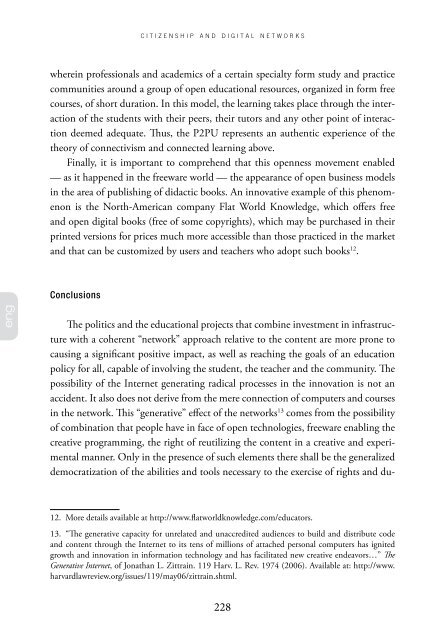Sergio Amadeu da Silveira - Cidadania e Redes Digitais
Sergio Amadeu da Silveira - Cidadania e Redes Digitais
Sergio Amadeu da Silveira - Cidadania e Redes Digitais
You also want an ePaper? Increase the reach of your titles
YUMPU automatically turns print PDFs into web optimized ePapers that Google loves.
eng<br />
c i t i z e n s h i p a n d d i g i t a l n e t w o r k s<br />
wherein professionals and academics of a certain specialty form study and practice<br />
communities around a group of open educational resources, organized in form free<br />
courses, of short duration. In this model, the learning takes place through the interaction<br />
of the students with their peers, their tutors and any other point of interaction<br />
deemed adequate. Thus, the P2PU represents an authentic experience of the<br />
theory of connectivism and connected learning above.<br />
Finally, it is important to comprehend that this openness movement enabled<br />
— as it happened in the freeware world — the appearance of open business models<br />
in the area of publishing of di<strong>da</strong>ctic books. An innovative example of this phenomenon<br />
is the North-American company Flat World Knowledge, which offers free<br />
and open digital books (free of some copyrights), which may be purchased in their<br />
printed versions for prices much more accessible than those practiced in the market<br />
and that can be customized by users and teachers who adopt such books 12 .<br />
Conclusions<br />
The politics and the educational projects that combine investment in infrastructure<br />
with a coherent “network” approach relative to the content are more prone to<br />
causing a significant positive impact, as well as reaching the goals of an education<br />
policy for all, capable of involving the student, the teacher and the community. The<br />
possibility of the Internet generating radical processes in the innovation is not an<br />
accident. It also does not derive from the mere connection of computers and courses<br />
in the network. This “generative” effect of the networks 13 comes from the possibility<br />
of combination that people have in face of open technologies, freeware enabling the<br />
creative programming, the right of reutilizing the content in a creative and experimental<br />
manner. Only in the presence of such elements there shall be the generalized<br />
democratization of the abilities and tools necessary to the exercise of rights and du-<br />
12. More details available at http://www.flatworldknowledge.com/educators.<br />
13. “The generative capacity for unrelated and unaccredited audiences to build and distribute code<br />
and content through the Internet to its tens of millions of attached personal computers has ignited<br />
growth and innovation in information technology and has facilitated new creative endeavors…” The<br />
Generative Internet, of Jonathan L. Zittrain. 119 Harv. L. Rev. 1974 (2006). Available at: http://www.<br />
harvardlawreview.org/issues/119/may06/zittrain.shtml.<br />
228


